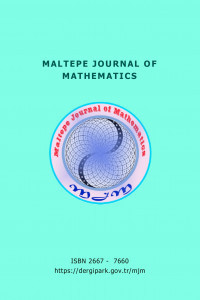STABILITY ANALYSIS OF A NOVEL ODE MODEL FOR HIV INFECTION
STABILITY ANALYSIS OF A NOVEL ODE MODEL FOR HIV INFECTION
HIV, globally asymptotical stability, periodic solution,
___
- [1] X. Song, and A. U. Neumann, Global stability and periodic solution of the viral dynamics, J. Math. Anal. Appl. 329 (2007) 281-297.
- [2] R. V. Culshaw, and S. Ruan, A delay - differential equation model of HIV infection of CD4+ T-cells, Math. Biosci. 165 (2000) 27-39.
- [3] G. Teschl, Ordinary Differential Equations and Dynamical Systems (2012), American Mathematical Society, Providence, ISBN 978-0-8218-8328-0.
- [4] R. J. De Boer, and A. S. Perelson, Target Cell Limited and Immune Control Models of HIV Infection: A Comparison 190 (1998) 201-214.
- [5] A. S. Perelson, Modelling the interaction of the immune system with HIV, In: C. Castillo-Chavez (Eds), Mathematical and Statistical Approaches to AIDS Epidemiology (1989) 250, Springer, Berlin.
- [6] A. S. Perelson, Dynamics of HIV Infection of CD4+ T-cells, Math. Biosci. 114 (1993) 81.
- [7] A. S. Perelson, A. U. Neumann, M. Markowitz, J. M. Leonard, and D.D. Ho, HIV-1 dynamics in vivo: virion clearance rate, infected cell life-span, and viral generation time, Science 271 (1996) 1582.
- [8] A. S. Perelson, and P. W. Nelson, Mathematical analysis of HIV-1 dynamics in vivo, SIAM Rev. 41 (1999) 3.
- [9] J. E. Mittler, B. Sulzer, A. U. Neumann, and A.S. Perelson, Influence of delayed viral production on viral dynamics in HIV-1 infected patients, Math. Biosci. 251 (1998) 143.
- [10] J. E. Mittler, M. Markowitz, D. D. Ho, and A. S. Perelson, Improved estimates for HIV-1 clearance rate and intracellular delay, AIDS 13 (1999) 1415.
- [11] R. M. Anderson, and R. M. May, Complex dynamical behavior in the interaction between HIV and the immune system, In: A. Goldbeter (Eds), Cell to Cell Signalling: From Experiments to Theoretical Models (1989) 335, Academic Press, New York.
- [12] A. R. McLean, and T. B. L. Kirkwood, A model of human immunodeficiency virus infection in T-helper cell clones, J. Theoret. Biol. 147 (1990) 177.
- [13] M. A. Nowak, and R. M. Bangham, Population dynamics of immune responses to persistent viruses, Science 272 (1996) 74.
- [14] D. E. Kirschner, Using mathematics to understand HIV immune dynamics, Notices Amer. Math. Soc. 43 (1996) 191.
- [15] Y. Kuang, Delay-Differential Equations with Applications in Population Dynamics (1993), Academic Press, New York.
- [16] A. V. M. Herz, S. Bonhoeffer, R. M. Anderson, R. M. May, and M. A. Nowak, Viral dynamics in vivo: limitations on estimates of intracellular delay and virus decay, Proc. Natl. Acad. Sci. USA 93 (1996) 7247.
- [17] J. Tam, Delay effect in a model for virus replication, Math. Med. Biol. 16 (1999) 29.
- [18] T. B. Kepler, and A.S. Perelson, Cyclic re-entry of germinal center B cells and the efficiency of affinity maturation, Immunology Today, 14 (1993) 412-415.
- [19] J. K. Percus, O. E. Percus, and A. S. Perelson, Predicting the size of the T -cell receptor and antibody combining region from consideration of efficient self–nonself discrimination, Proc. Natl. Acad. Sci. USA 90 (1993) 2691-2695.
- [20] F. R. Gantmacher, The Theory of Matrices (1959), Chelsea Publishing Company, New York.
- [21] H. R. Zhu, H. L. Smith, and M. W. Hirsch, Stable periodic orbits for a class of three dimensional competitive systems, J. Differential Equations 110 (1994) 143-156.
- [22] M. W. Hirsch, System of differential equations which are competitive or cooperative, IV, SIAM J. Math. Anal. 21 (1990) 1225-1234.
- [23] G. Butler, H. I. Freedman, and P. Waltma, Uniform persistence system, Proc. Amer. Math. Soc. 96 (1986) 425-430.
- [24] H. L. Smith, and H. Thieme, Convergence for strongly ordered preserving semiflows, SIAM J. Math. Anal. 22 (1991) 1081-1101.
- [25] J. S. Muldowney, Compound matrices and ordinary differential equations, Rocky Mountain J. Math. 20 (1990) 857-872.
- [26] Y. Li, and J. S. Muldowney, Global stability for the SEIR model in epidemiology, Math. Biosci. 125 (1995) 115-164.
- [27] International Committee on Taxonomy of Viruses, Taxonomy (2019), National Institutes of Health, URL: https://talk.ictvonline.org/taxonomy/
- [28] R. Harvey, Microbiology (3rd ed.) (2012) 295-306, Lippincott Williams and Wilkins, Philadelphia, PA.
- [29] C. Rackauckas, and Q. Nie, DifferentialEquations.jl - A Performant and Feature-Rich Ecosystem for Solving Differential Equations in Julia, J. Open Res. Softw. 5(1) 2017 15.
- ISSN: 2667-7660
- Yayın Aralığı: Yılda 2 Sayı
- Başlangıç: 2019
- Yayıncı: Hüseyin ÇAKALLI
On a mean method of summability
STABILITY ANALYSIS OF A NOVEL ODE MODEL FOR HIV INFECTION
Hoang NGO, Hung DANG NGUYEN, Mehmet DİK
COMPACTIFICATIONS OF A FIXED SET
Arulmani INDUMATHI, Ayhan ESİ, Nagarajan SUBRAMANİAN, Mustafa Kemal ÖZDEMİR
Reduction method for functional nonconvex differential inclusions
